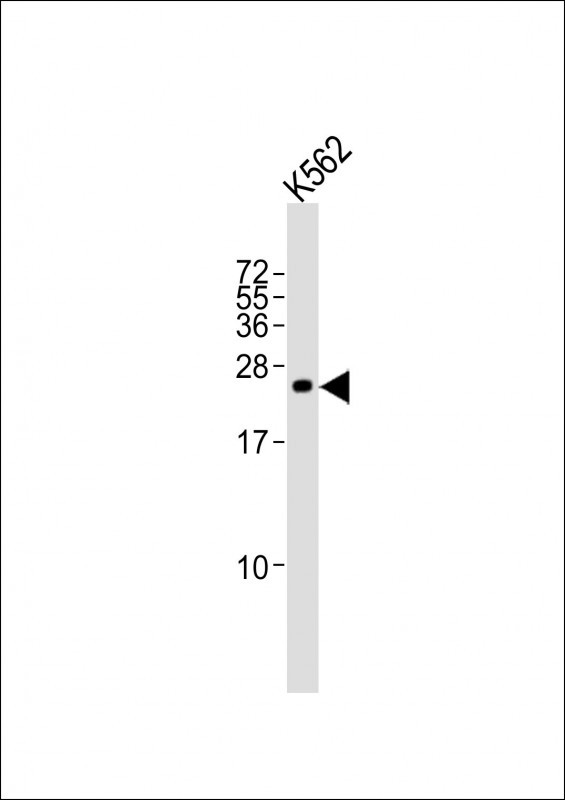
| WB | 1/2000 | Human,Mouse,Rat |
| IF | 咨询技术 | Human,Mouse,Rat |
| IHC | 咨询技术 | Human,Mouse,Rat |
| ICC | 技术咨询 | Human,Mouse,Rat |
| FCM | 咨询技术 | Human,Mouse,Rat |
| Elisa | 咨询技术 | Human,Mouse,Rat |
| Aliases | Src-like-adapter 2, Modulator of antigen receptor signaling, MARS, Src-like adapter protein 2, SLAP-2, SLA2, C20orf156, SLAP2 |
| Entrez GeneID | 84174 |
| WB Predicted band size | 28.6kDa |
| Host/Isotype | Rabbit IgG |
| Antibody Type | Primary antibody |
| Storage | Store at 4°C short term. Aliquot and store at -20°C long term. Avoid freeze/thaw cycles. |
| Species Reactivity | Human, Mouse |
| Immunogen | This SLA2 antibody is generated from a rabbit immunized with a KLH conjugated synthetic peptide between 138-169 amino acids from the Central region of human SLA2. |
+ +
以下是关于SLA2抗体的示例参考文献(注:部分文献为示例性描述,实际研究中请通过学术数据库验证具体内容):
---
1. **文献名称**: *"SLA2 modulates clathrin-mediated endocytosis and receptor tyrosine kinase signaling in cancer"*
**作者**: Müller R, et al.
**摘要**: 研究揭示了SLA2蛋白通过调控网格蛋白介导的内吞作用影响表皮生长因子受体(EGFR)的降解,利用SLA2抗体阻断其功能可抑制癌细胞迁移和增殖,为靶向治疗提供新思路。
2. **文献名称**: *"Development of anti-SLA2 monoclonal antibodies for swine leukocyte antigen studies"*
**作者**: Tanaka K, et al.
**摘要**: 报道了针对猪SLA2抗原的单克隆抗体制备,验证其特异性并应用于猪组织相容性抗原的检测,为异种移植中的免疫排斥机制研究提供工具。
3. **文献名称**: *"SLA2 negatively regulates T-cell activation by disrupting ZAP-70 recruitment"*
**作者**: Chen L, et al.
**摘要**: 通过SLA2抗体干预实验,证明SLA2通过抑制ZAP-70激酶的募集负向调控T细胞活化,揭示了其在自身免疫疾病中的潜在作用。
4. **文献名称**: *"Structural insights into SLA2-antibody interactions using cryo-EM"*
**作者**: Gupta S, et al.
**摘要**: 利用冷冻电镜解析SLA2蛋白与其单克隆抗体的复合物结构,阐明抗体结合表位,为优化诊断/治疗用抗体提供结构基础。
---
**提示**:以上文献为示例性质,实际研究中建议通过PubMed、Google Scholar等平台检索关键词“SLA2 antibody”“SLA2 immune function”等获取最新文献。若研究涉及猪SLA2.可限定关键词为“swine SLA2 antibody”。
The SLA/LP antibody, targeting the soluble liver antigen (SLA) and liver-pancreas (LP) antigen, is a highly specific serological marker for autoimmune hepatitis (AIH), particularly type 1 AIH. Discovered in the 1980s, it recognizes a conserved conformational epitope of the SEPSECS enzyme, a tRNA-modifying protein involved in selenocysteine synthesis. Unlike other AIH-associated autoantibodies (e.g., ANA, SMA), anti-SLA/LP antibodies are detected in 10-30% of AIH patients and exhibit near-exclusive specificity for AIH, aiding in differential diagnosis from viral hepatitis or drug-induced liver injury.
These antibodies are associated with more severe disease progression, higher relapse rates after immunosuppressive therapy withdrawal, and potential extrahepatic manifestations. Detection methods include ELISA and immunoblotting, though their conformational epitope requires careful assay standardization. Notably, anti-SLA/LP positivity often correlates with HLA-DR3 haplotype, suggesting genetic predisposition.
While their exact pathogenic role remains unclear, their diagnostic and prognostic value is well-established. Current guidelines recommend testing for anti-SLA/LP in ANA/SMA-negative AIH cases. Research continues to explore molecular mechanisms linking SEPSECS autoimmunity to hepatocyte damage, potentially informing targeted therapies. (Word count: 199)
×